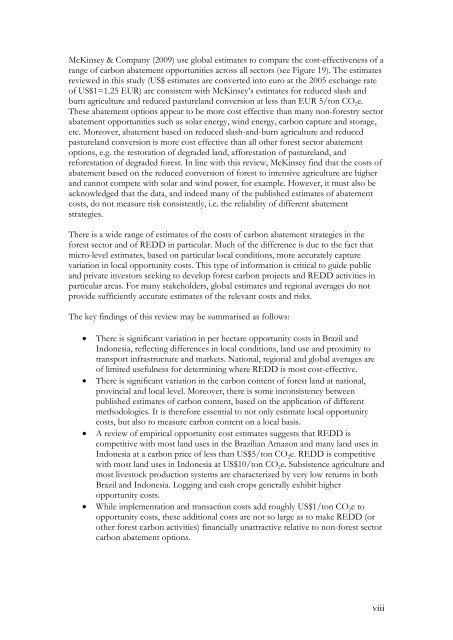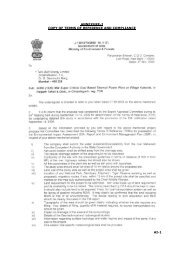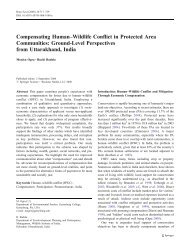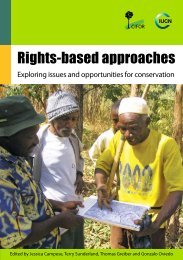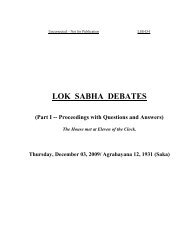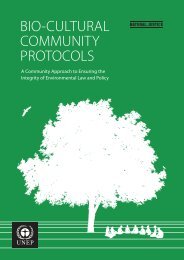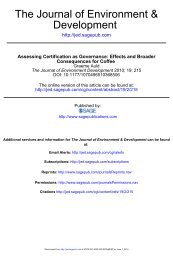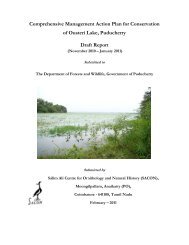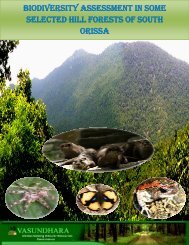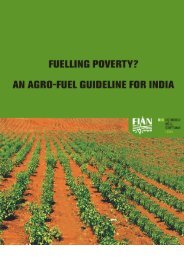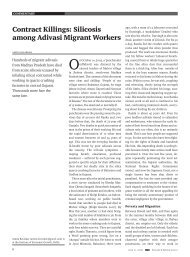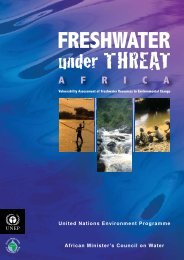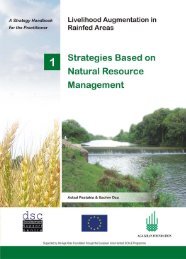The Financial Costs of REDD: - India Environment Portal
The Financial Costs of REDD: - India Environment Portal
The Financial Costs of REDD: - India Environment Portal
Create successful ePaper yourself
Turn your PDF publications into a flip-book with our unique Google optimized e-Paper software.
McKinsey & Company (2009) use global estimates to compare the cost-effectiveness <strong>of</strong> a<br />
range <strong>of</strong> carbon abatement opportunities across all sectors (see Figure 19). <strong>The</strong> estimates<br />
reviewed in this study (US$ estimates are converted into euro at the 2005 exchange rate<br />
<strong>of</strong> US$1=1.25 EUR) are consistent with McKinsey’s estimates for reduced slash and<br />
burn agriculture and reduced pastureland conversion at less than EUR 5/ton CO 2 e.<br />
<strong>The</strong>se abatement options appear to be more cost effective than many non-forestry sector<br />
abatement opportunities such as solar energy, wind energy, carbon capture and storage,<br />
etc. Moreover, abatement based on reduced slash-and-burn agriculture and reduced<br />
pastureland conversion is more cost effective than all other forest sector abatement<br />
options, e.g. the restoration <strong>of</strong> degraded land, afforestation <strong>of</strong> pastureland, and<br />
reforestation <strong>of</strong> degraded forest. In line with this review, McKinsey find that the costs <strong>of</strong><br />
abatement based on the reduced conversion <strong>of</strong> forest to intensive agriculture are higher<br />
and cannot compete with solar and wind power, for example. However, it must also be<br />
acknowledged that the data, and indeed many <strong>of</strong> the published estimates <strong>of</strong> abatement<br />
costs, do not measure risk consistently, i.e. the reliability <strong>of</strong> different abatement<br />
strategies.<br />
<strong>The</strong>re is a wide range <strong>of</strong> estimates <strong>of</strong> the costs <strong>of</strong> carbon abatement strategies in the<br />
forest sector and <strong>of</strong> <strong>REDD</strong> in particular. Much <strong>of</strong> the difference is due to the fact that<br />
micro-level estimates, based on particular local conditions, more accurately capture<br />
variation in local opportunity costs. This type <strong>of</strong> information is critical to guide public<br />
and private investors seeking to develop forest carbon projects and <strong>REDD</strong> activities in<br />
particular areas. For many stakeholders, global estimates and regional averages do not<br />
provide sufficiently accurate estimates <strong>of</strong> the relevant costs and risks.<br />
<strong>The</strong> key findings <strong>of</strong> this review may be summarised as follows:<br />
• <strong>The</strong>re is significant variation in per hectare opportunity costs in Brazil and<br />
Indonesia, reflecting differences in local conditions, land use and proximity to<br />
transport infrastructure and markets. National, regional and global averages are<br />
<strong>of</strong> limited usefulness for determining where <strong>REDD</strong> is most cost-effective.<br />
• <strong>The</strong>re is significant variation in the carbon content <strong>of</strong> forest land at national,<br />
provincial and local level. Moreover, there is some inconsistency between<br />
published estimates <strong>of</strong> carbon content, based on the application <strong>of</strong> different<br />
methodologies. It is therefore essential to not only estimate local opportunity<br />
costs, but also to measure carbon content on a local basis.<br />
• A review <strong>of</strong> empirical opportunity cost estimates suggests that <strong>REDD</strong> is<br />
competitive with most land uses in the Brazilian Amazon and many land uses in<br />
Indonesia at a carbon price <strong>of</strong> less than US$5/ton CO 2 e. <strong>REDD</strong> is competitive<br />
with most land uses in Indonesia at US$10/ton CO 2 e. Subsistence agriculture and<br />
most livestock production systems are characterized by very low returns in both<br />
Brazil and Indonesia. Logging and cash crops generally exhibit higher<br />
opportunity costs.<br />
• While implementation and transaction costs add roughly US$1/ton CO 2 e to<br />
opportunity costs, these additional costs are not so large as to make <strong>REDD</strong> (or<br />
other forest carbon activities) financially unattractive relative to non-forest sector<br />
carbon abatement options.<br />
viii


